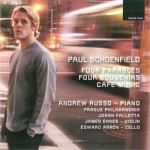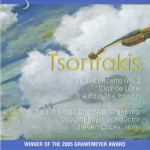Column Name
Title
Paul Schoenfield: Four Parables, Four Souvenirs, Café Music. Andrew Russo, piano; James Ehnes, violin; Edward Arron, cello; Prague Philharmonia, JoAnn Falletta, conductor. (Black Box BBM 1109)
Body
My introduction to Paul Schoenfield’s exuberant Four Parables (1982-83) was at Juilliard’s 1992 Focus! festival, with pianist and alumnus Stephen Gosling, and shortly after that an excellent recording appeared with another Juilliard alum, Jeffrey Kahane, on Argo (now out of print). This might be one of the great piano concertos of the late 20th century—it is certainly one of the most entertaining—and a fine reminder that hard-edged atonality remains but one avenue available to composers. Schoenfield’s canvas is a psychedelic mix of jazz-meets-Nancarrow with some Porgy and Bess thrown in—as rangy as a blues singer and as manic as a Road Runner cartoon. This new recording with pianist Andrew Russo, who earned a master’s degree at Juilliard in 1998, is anchored with fizz and grace by conductor and Juilliard alumna JoAnn Falletta and alert playing from the Prague Philharmonia, and boasts fine-grained sound from Prague’s famous Rudolfinium.
Yet another Juilliard alum, violinist James Ehnes (B.M. 1997), joins Russo for Four Souvenirs (1989), in its world-premiere recording. This is indeed an energetic addition to the violin and piano repertoire. In the first movement, a samba, Ehnes grabs the spine with gusto, then relaxes into the melancholy tango that follows. A nostalgic “Tin Pan Alley” could be lifted from a 1930s film soundtrack, but its appearance is brief, before a hyperkinetic “Square Dance” burns down the house in flames of syncopation. Ehnes and Russo hurl themselves into this music with complete commitment, and the clear recording from Syracuse University’s Setnor Hall does everyone proud.
Still another Juilliard alumnus, cellist Edward Arron (B.M. 1998), joins Ehnes and Russo for Café Music (1986), one of the composer’s most popular scores, its 15 minutes filled with virtuosity and droll humor (imagine Paganini stumbling into a roadside honky-tonk bar in Tennessee). These three musicians capture every scrap.
George Tsontakis: Violin Concerto No. 2; Clair de Lune; The Past, the Passion. Steven Copes, violin; St. Paul Chamber Orchestra, Douglas Boyd, conductor. (Koch KIC-CD-7592)
Luminosity defines George Tsontakis’s Second Violin Concerto (2003), which begins with high strings and percussion before the violin enters, weaving its way through its colleagues, as Damian Thompson writes in his liner notes, “like a charming but restless guest at a party.” In the opening, “Surges (among stars),” violinist and Juilliard alum Steven Copes (M.M. 1996) is that restless guest, gliding through the composer’s night sky with the St. Paul Chamber Orchestra, led with gentle yet powerful focus by Douglas Boyd. Copes is irresistibly fresh throughout this glistening, compact concerto (winner of the 2005 Grawemeyer Award) which treats the soloist and orchestra as equal partners. And like the rest of the program, engineer John Scharf provides crystalline work from the SPCO Center in St. Paul, Minn.
In a clear homage to Debussy, Tsontakis, who holds master’s and doctoral degrees from Juilliard, uses scales right out of La Mer in Clair de Lune (2007), written for the composer’s mother. The score is moody and reflective, especially in the opening “Moonlit,” swelling with rich harmonies and voluptuous orchestration. But in the second section, “Jeux–Ballet Moon (Pas de Deux),” an impish woodwind figure—almost mécanique—leads the rest of the ensemble in translucent interplay. After a brief recall of the initial lunar motif the mechanical twittering returns before the piece trickles off into nothingness.
From 1987, The Past, the Passion is a memorial for the composer’s father for 14 players, and shares the clear interest in French texture and style that flowered in the two previous works. The dedicatee must have been fascinating, if the chameleon-like changes shown here provide a clue. And as with many other composers, Tsontakis finds inspiration in music from 400 years ago. After a shimmering four-note figure runs wild in the introduction, the strings enter with Herzlich tut mich verlangen, a melody by Hans Leo Hassler (1564-1612) repeatedly harmonized by J.S. Bach (five times in his St. Matthew Passion). As the swirling motif eventually dies out, it is replaced by delicate filigree on bells and piano, as the chorale takes center stage.






